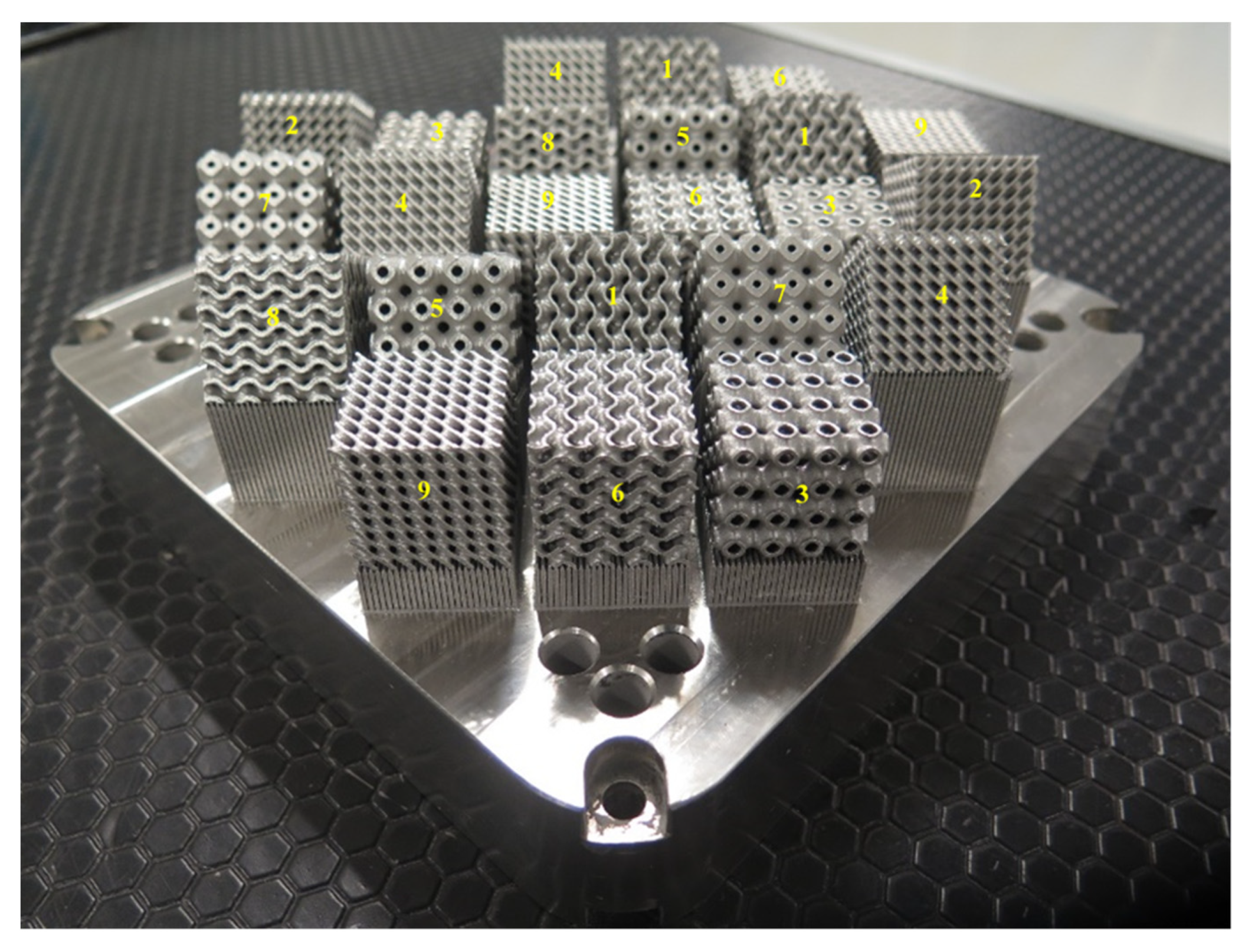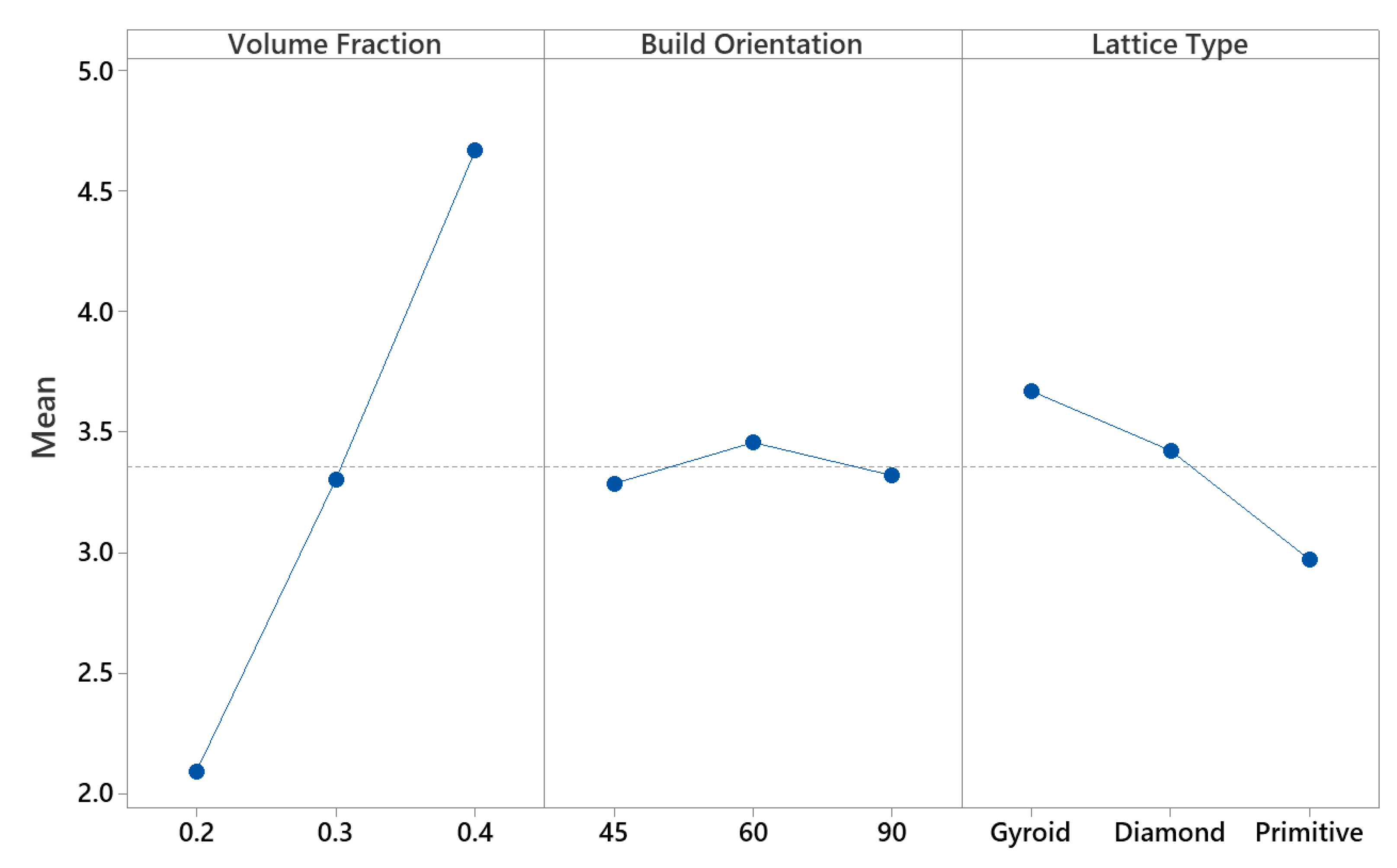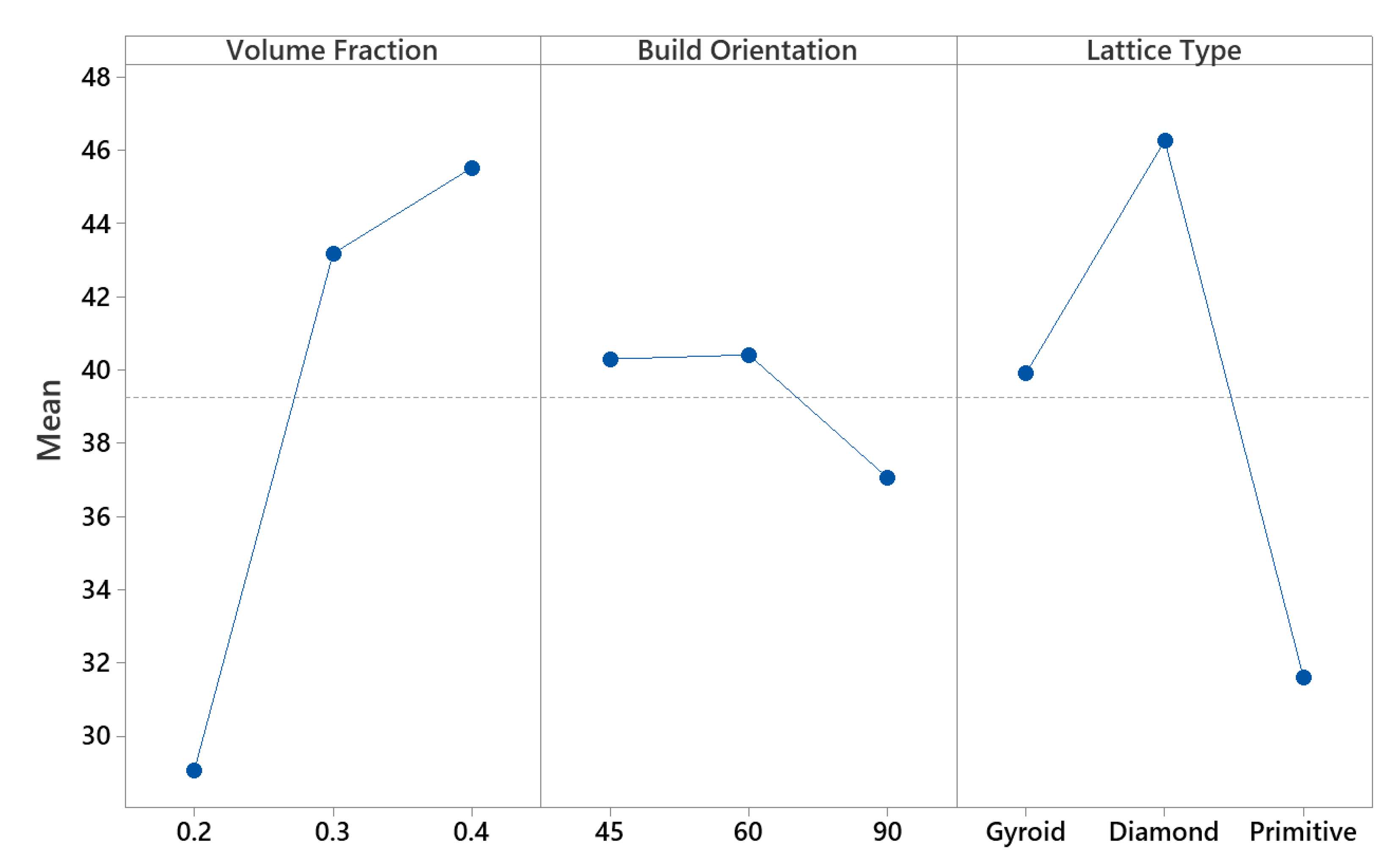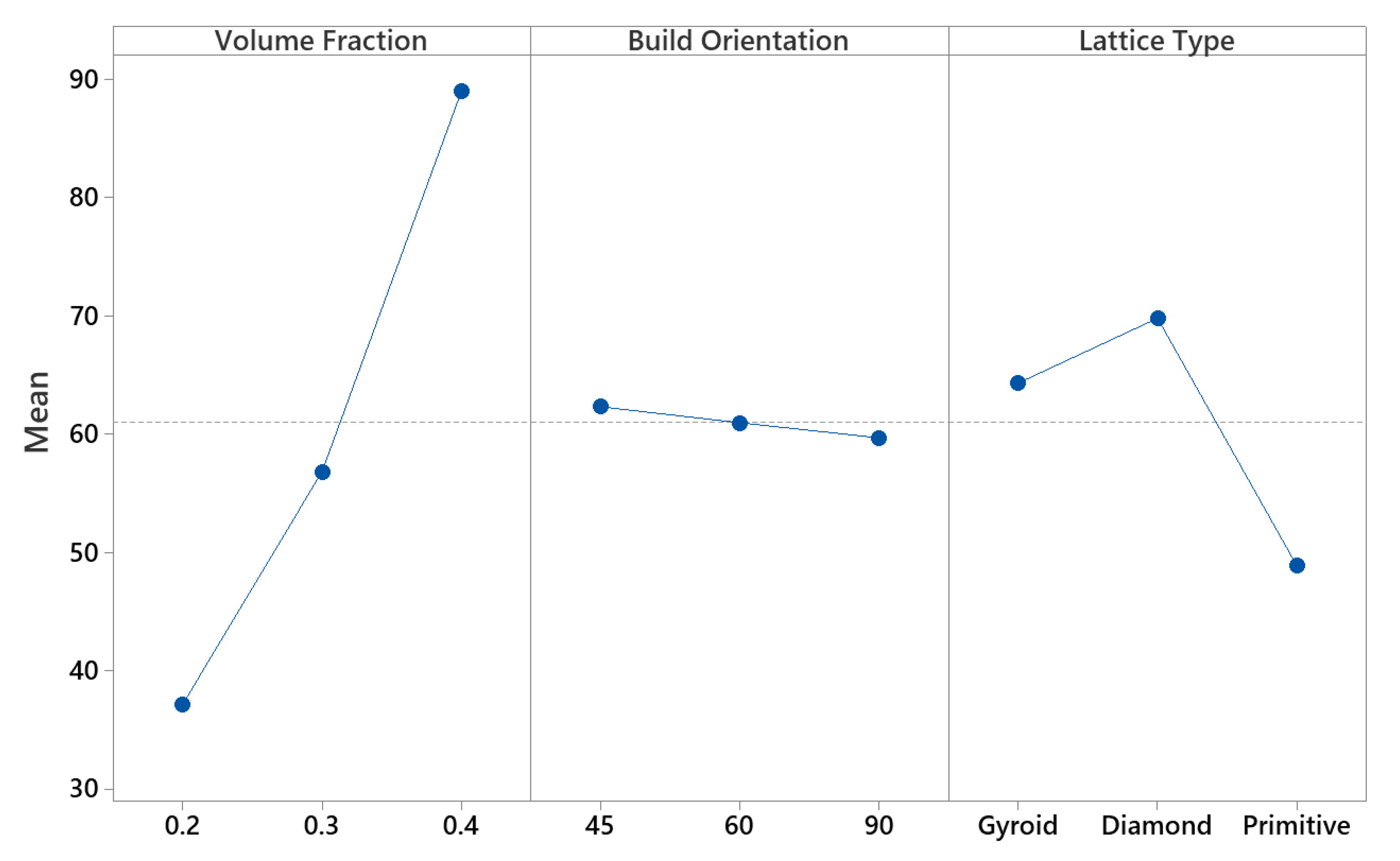1. Introduction
The necessity of using light and durable materials in aviation, automotive, sports, and biomedical industries has led researchers to investigate different types of materials and structures in several applications. Lattice structures are one type of such structures that have received great attention in recent years. These are three-dimensional structures consisting of one or more repeating unit cells [
1]. Compared to solid monolithic structures, these structures have been used in different applications due to their ability to absorb higher energy, to provide higher sound insulation, and their thermal management capability [
2,
3]. Lattice structures can be categorized as strut-based lattice structures, shell lattice structures, and triply periodic minimum surface (TPMS) lattice structures in terms of their geometrical shapes [
4].
TPMS lattice structures are three-dimensional structures formed by mathematical equations, and have zero mean curvature. They were first investigated by Schwarz in 1856. He expressed the surfaces created as Diamond and Primitive. Neovius further advanced the study and obtained a Primitive cubic (C(P)) surface [
5]. In the 1960s, Schoen proposed IWP (I-Graph-Wrapped Package), FRD (F-Rhombic Dodecahedron), and G (Gyroid) surfaces [
6]. Fischer and Koch in 1987 [
7] and Gozdz and Holyst in 1990 [
8] discovered new TPMS surfaces after their long studies.
Complex geometries of TPMS structures make the manufacturing of these structures very difficult, but today, additive manufacturing (AM) provides novel solutions for the production of different types of TPMS structures. Laser Powder Bed Fusion (LPBF) is one of the metal AM processes where metal powders are placed on a build plate with an amount of pre-defined thickness by recoater blade, and a laser source is used to selectively melt the powder according to computer-aided design geometry in an inert gas atmosphere. When one layer is scanned and melted, the build plate is lowered with an amount of layer thickness, and the new layer of powder is laid on the previous layer. This process continues until the final part is fully formed [
9].
In scientific literature, a number of studies have focused on the mechanical properties of different types of TPMS lattice structures produced by AM. In terms of their mechanical behaviors, TPMS structures can show stretch-dominated or bending-dominated behaviors [
10]. It was reported that Primitive structures have higher elastic modulus (E) and compressive strength, and show stretch-dominated behavior than Diamond and Gyroid structures, which have bending-dominated behaviors, based on the experimental results with selective laser-sintered specimens from PA 2200 material. Therefore, it was suggested to use Primitive structures in applications where high strength is needed, and Diamond and Gyroid structures in applications where high strain before plastic deformation is needed [
11]. In another study, Restrepo et al. [
12] compared ceramic Primitive-, Gyroid-, and Diamond-type lattice structures, and concluded that Primitive showed the highest E and yield strength (
σy), whereas Gyroid showed the lowest values. Castro et al. [
13] compared the compressive behavior of Diamond, Primitive, and Gyroid TPMS structures from Visijet M3 Crystal material with different volume fractions (0.2, 0.3, and 0.4). Their study revealed that a Diamond structure with 0.4 volume fraction showed the highest elastic modulus and yield stress. On the other hand, a Diamond structure with 0.2 volume fraction showed the lowest elastic modulus, and a Primitive structure with 0.2 volume fraction showed the lowest yield stress. Abueidda et al. [
14] compared the mechanical properties of selective laser-sintered Gyroid structures with Neovius, IWP, and Primitive structures from PA 2200 material. They stated that Neovius and IWP structures showed the highest and a Primitive structure showed the lowest compressive strength and energy absorption ability. Al Mahri et al. [
15] studied the quasi-static and dynamic response of Gyroid, Diamond, IWP, Primitive, and Fisher Kock TPMS lattice structures produced with an LPBF process from 316L stainless steel. Their results revealed that IWP showed the highest and Primitive showed the lowest plateau stress in both loading conditions. In terms of energy absorption ability, Diamond offers the highest and Primitive offers the lowest values. Zhang et al. [
16] stated that a Diamond structure showed higher mechanical properties than Gyroid and Primitive structures produced with LPBF from 316L stainless steel material. Liang et al.’s study [
17] on 316L stainless steel LPBF-manufactured Gyroid and Primitive structures showed that the Primitive structure showed stretch-dominated behavior, and the Gyroid structure showed bending-dominated behavior. Moreover, the Primitive structure showed higher energy absorption ability than the Gyroid structure at low relative densities. Novak et al. [
18] compared quasi static and dynamic compressive behavior of LPBF-produced 316L stainless steel Diamond, Gyroid, IWP, and Primitive TPMS structures, and stated that the Diamond structure showed the highest and the Primitive structure showed the lowest plateau stress and specific energy absorption. Shi et al. [
19] investigated compressive and energy absorption behavior of LPBF-produced Ti6Al4V Gyroid, Primitive, Diamond, and IWP TPMS structures, and stated that the Gyroid and IWP structures showed higher plateau stress and energy absorption than other TPMS structures. They also stated that for Gyroid and IWP structures, elastic modulus and yield stress increased with increasing relative density. It is clear from this short literature survey that the mechanical properties of different types of AM-produced TPMS lattice structures in the literature might be contradictory due to the manufacturing methods, defects, dimensional variations, and surface roughness of manufactured specimens [
4].
Apart from the type, the mechanical properties of TPMS lattice structures are affected by build orientation and volume fraction [
20]. Cai et al. [
21] investigated the effect of porosity on mechanical properties of PLA Diamond TPMS structures. They stated that low-porosity samples had 3 times higher yield stress and 2.5 times higher elastic modulus than high-porosity samples. The build orientation effect on mechanical properties was studied by Alsalla et al. [
22] for LPBF-manufactured 316L Gyroid lattice structures. They stated that vertically-oriented samples showed 60% higher
σy than horizontally-oriented ones. The main reason for the effect of different build orientations on the mechanical properties is the different porosity values for build parts. Delroisse et al. [
23] stated that LPBF-manufactured AlSi10Mg vertically-built samples showed a lower amount of porosity than samples with different build angles. It is also worth noting that build orientation affects the microstructural development in LPBF-printed specimens. In LPBF, usually, columnar grains oriented in the build direction are formed [
24], and these grains are long and thin at the bottom of the specimens near the build plate due to large thermal gradients and high cooling rates [
25] and become coarser at higher build heights due to the lower thermal gradients between successive layers [
26]. However, the microstructure development in lattice structures is more complicated and diverse [
27], which affects the mechanical properties of the printed specimen [
28].
As can be seen from the aforementioned literature, there has been many studies performed about investigating the effect of build orientation, volume fraction, and different types of lattice structures on mechanical performance, especially on E and
σy. It is also very important to know the significance of the effect of these parameters on mechanical properties so that the design engineer can have the knowledge to change the parameters in the right order to acquire the intended strength and improve the quality of AM parts. However, most of the research works focused on the effect of process parameters on mechanical properties. For instance, in one of the studies, laser power, scan speed, hatch spacing, and layer thickness were chosen as design parameters, and correlations between these parameters were shown in LPBF-produced Inconel 718 specimens [
29]. In another study, Dong et al. [
30] used Taguchi analysis to find the optimum process parameters for the mechanical properties of fused deposition modelled ABS lattice parts. They used nozzle temperature, print speed, fan speed, and layer height as input parameters to be optimized for two different type of lattice structure: horizontal and inclined struts. To the best of the authors’ knowledge, there are limited studies on the percent contribution of geometrical parameters (build orientation, volume fraction, and lattice type) on the mechanical properties of TPMS lattice-structured metal parts produced by LPBF. Moreover, most of the research works related with LPBF processes used Ti6Al4V, 316L stainless steel, AlSi10Mg, and nickel-based superalloys such as Inconel 718. Moreover, it was observed that no studies have focused on the mechanical properties of Gyroid, Diamond, and Primitive lattice structures produced by LPBF from CoCrMo material so far. In their study, Park et al. [
31] used CoCrMo powder material to produce IWP and Neovius TPMS structures with the LPBF method and compared the mechanical properties of these lattices under compression.
To fill these gaps, this experimental research focuses on the impact of three different parameters (build orientation, volume fraction, and lattice type) on E, σy, and the specific energy absorption of lattice structures produced by LPBF using CoCrMo alloy. The Taguchi experimental design method is used in the settings of lattice parameters during experimental studies. The level of importance of the lattice parameters on E, σy, and specific energy absorption is determined by using analysis of variance (ANOVA) analysis.

















